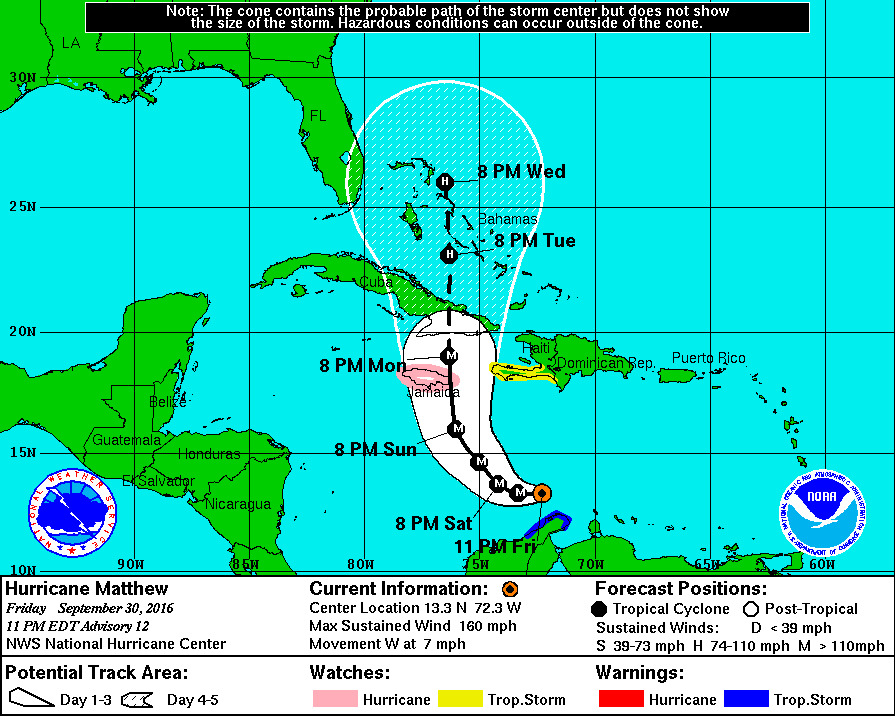I’ve been watching this system since it was just a blip coming off the coast of Africa. At the time, I was smugly thinking, We’re nearly through hurricane season and it’s all been good for Florida, with hurricanes heading away form the coast and out into the Atlantic. On Wednesday, as the system entered the Caribbean, it was barely a tropical storm. In just 48 hours (I’m writing this on Friday night), it has intensified despite wind shear and become a category 5 hurricane, with winds of 160 MPH.
The National Hurricane Center bases its predictions on a variety of factors and one of them is what storms on this track have done in the past. What worries me is the last sentence in this paragraph from their 11 p.m. advisory Friday night. I’ve highlighted it:
Matthew probably is near its peak intensity and will likely maintain a similar strength during the next 12 hours or so. Data from the reconnaissance plane show an incipient outer band of maximum winds, indicating that an eyewall replacement cycle could occur soon. This should result in fluctuations in intensity, and given that southwesterly shear is still affecting the cyclone, some weakening is anticipated. However, Matthew is forecast to be a category 4 hurricane by the time it moves near Jamaica and eastern Cuba. Some additional weakening is expected over the high terrain of Cuba. It is noted that none the guidance ever indicated the rapid strengthening of Matthew.
In other words, this is the kind of storm that authors Whitley Strieber and Art Bell wrote about in their book The Coming Global Superstorm, the basis for the movie The Day After Tomorrow. It’s an outlier, a rogue that may become the new norm, probably a result of climate change. The past history of storms on similar tracks, the models that show what this storm may do, may not be much help anymore.
During hurricane season, I use a free app called Max Tracker, developed by Max Mayfield, former director of the National Hurricane Center. He was director of the center for years and I always admired his acumen about hurricanes. The app indicates that by Wednesday, as Matthew near the Bahamas, it will be a cat 2 with 110 mph winds. The cone of uncertainty includes part of the east coast of South Florida to around Melbourne and as far west as Lake Okeechobee. The tri-county area – Miami/Dade, Fort Lauderdale, and Palm Beach County fall within the cone. With a slight shift of the track to the west, which depends on several upper level troughs, it hits our area.
We were last hit in 2005, when Wilma swept across the peninsula, a cat 1 that during her travels had the lowest ever recorded barometric pressure – 881 mb. Even though she was fast-moving and greatly diminished when she hit us, she stalled over our area and her back side, which is supposed to be less fierce, was a monster. She left us without power for 10 days. Matthew’s barometric as of tonight is 941 mb. It has dropped from around 1008 to that 941 in about 24 hours.
When I look at the satellite images, my sense is that Matthew, like all hurricanes, perhaps like all weather, is sentient, some form of consciousness that we don’t understand, something that gravitates toward particular areas because it’s drawn by the collective consciousness of the people who live there. You won’t find any reference to that on the National Hurricane Center site or any other weather site. But in studying these systems since my first hurricane in the 60s- Hurricane Cleo – that’s my intuitive impression.
My hope is that this sucker turns out into the Atlantic and hits nothing. The NHC ends their discussion with this:
It is important to remind users that average NHC track forecast errors are around 175 miles at day 4 and 230 miles at day 5. Therefore, it is too soon to rule out possible hurricane impacts from Matthew in Florida.
Maybe by tomorrow, the track has shifted east, away from Florida and the Bahamas.









I think it was Art Bell who did an experiment using large numbers of people from his Coast to Coast audience to move a storm away from land, or something like that. My vague memory is that it was so effective, that it scared him, and he didn’t try it again.
Let’s get organized and do this — in hurricane country, tornado country, and my fire and earthquake country!
I’m starting now — requesting Matthew to move out to sea.
Thanks, Shiela! I think it was Art Bell…